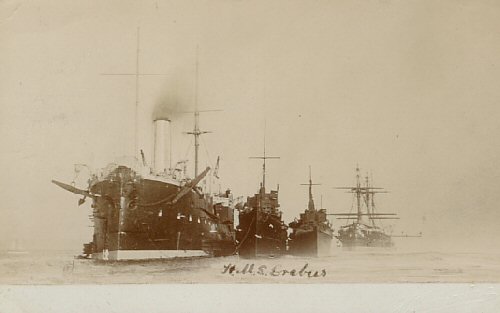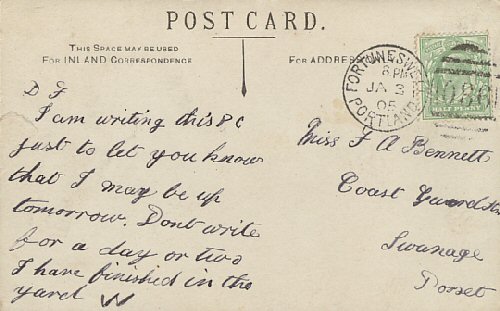
Foundered 16 September 1914
The seventh “INVINCIBLE” was a twin-screw 14-gun broadside ironclad, launched at Glasgow in 1869. She was of 6010 tons, 4830 horse-power, and 14 knots speed. Her length, beam, and draught were 280ft., 54ft., and 23ft. In 1873 the “Invincible,” commanded by Captain John Clark Soady, was one of a small squadron under Vice-Admiral Sir Hastings Yelverton, which proceeded to the Spanish coast and established a blockade of the Spanish Mediterranean littoral. She assisted in the operations against the Spanish Intransigentes and prevented the insurgent ships from bombarding various coastal towns. In 1879 the “Invincible,” commanded by Captain Lindesay Brine, was one of a squadron of seven ships which occupied the island of Cyprus under Vice-Admiral Lord John Hay with his flag in “Minotaur.” In 1882 the “Invincible,” took part in the Egyptian War. In July 1882 the “Invincible,” commanded by Captain Robert More Molyneux, lay at Alexandria in a fleet of 14 ships commanded by Admiral Sir Beauchamp Seymour with his flag in “Alexandra.” The Egyptians having failed to surrender their forts, the Admiral transferred his flag to the lighter draught ship “Invincible,” and on July 11th at 7a.m. the “Alexandra” fired the first shot in bombardment of Alexandria. The “Invincible,” with two other ships, was stationed inside the harbour, and she fought at anchor with a spring on her cable. All ships were cleared for action, topgallant masts being struck and bowsprits rigged in. By 7.10 a.m. all ships were engaged, and all the forts that could bring their guns to bear replied with vigour. By 5 p.m. all guns ashore had been silenced and the fleet ceased bombarding at 5:30 p.m. The “Invincible” had several dents on her armour, and was penetrated more than once outside it. The British casualties were 5 killed and 28 wounded , to which the “Invincible” contributed 6 wounded, including Midshipman Walter Lumsden. The Egyptian loss has never been properly ascertained, but it is believed to have been about 150 killed and 400 wounded , out of the 200 men engaged in working the forts. On July 13th the “Invincible,” and other ships steamed into the harbour, and landed men who occupied and policed the town, Paymaster Stanton of this ship becoming the Head of the Commissariat. On August 5th the “Invincible” contributed to a Naval Brigade which left Alexandria in the armoured train which was commanded by Captain John Fisher, of the “Inflexible.” Commander Reginald F.H. Henderson, of the “Invincible,” accompanied the brigade. The marines were detrained about 800 yards from Mehallet Junction, and assisted by a 40-pounder Armstrong gun, quickly dislodged the enemy. During the evening the brigade was exposed to a galling fire, but the marines behaved with great gallantry, and bore the brunt of the attack. The casualties in this affair were 1 marine killed and 12 wounded, and 1 seaman killed and 4 wounded. The Naval Brigade were then recalled to their ships. In 1885 the “Invincible” contributed to a Naval Brigade which operated on the Nile, under Captain Lord Charles Beresford. It took part in the battles of Abu Klea, Metemmeh, and Wad-Habeshi, and the relief of Sir Charles Wilson. Captain Robert More Molyneux was rewarded with the C.B. for his services. In 1904 this ship’s name was changed to “Erebus.” At a later date her name was changed again to “Fisgard,” and she was merged into the establishment for the training of boy artificers in Portsmouth harbour. On September 16th, 1914, this ship foundered off Portland in a heavy gale. She was being towed at the time, and 21 men were drowned out of the 64 on board.
